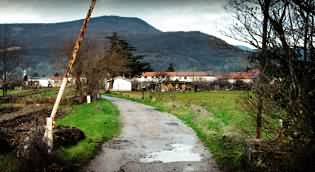

dell'11 febbraio 2001
A land without borders: 16,000 illegal immigrants were stopped around Gorizia, in north-east Italy, last year. Several times as many again are thought to have got through.
By Kevin Buckley
 JACK
Straw has never met Luigi Zoff. But when the Home Secretary goes to Stockholm
tomorrow to discuss the EUís immigration crisis, he could do worse than
suggesting they all hop on a train to Gorizia.
JACK
Straw has never met Luigi Zoff. But when the Home Secretary goes to Stockholm
tomorrow to discuss the EUís immigration crisis, he could do worse than
suggesting they all hop on a train to Gorizia.
There they would learn about the hard reality of border controls from the 59-year-old smallholder in Friuli-Venezia Giulia in north-east Italy.
Pointing 15 yards to his left, Luigi says: "Over thereís where we grow the kiwi crop." Then, motioning 15 yards to his right: "And thatís where I usually have the tomatoes." The kiwis are in Italy, the tomatoes in Slovenia, taxes paid to Rome and Ljubljana respectively.
So much for ĎFortress Europeí. In these parts it amounts to 18 in blocks sticking out of the ground at irregular intervals. Carefully numbered, they track the seemingly arbitrary route laid down by the map-makers who created the post-war border in 1945 when Italyís alliance with the losing side cost it territory to Yugoslavia.
"I saw one at first, then about a dozen of them. They werenít Slovenians but Turks, Kurds or something - running across the yard." It was around 6am on Wednesday. A tactic of passeurs, as they are known locally, is to head for the 6.30am train to the regional capital, Udine, safe in the knowledge that the police post at the railway station does not open until 7am.
The majority of the migrants fly into Sarajevo where they are briefed by the gangsters who organise the illegal immigration. They are told to claim they are tourists before they are infiltrated from Bosnia, to Croatia, to Slovenia from where it is a simple step into the EUís free movement Schengen zone.
The coast of southern Italy is also a major portal for illegal immigrants. Coastguards can only watch as Albanian gangsters dump their human loads on the Adriatic coast from speed boats.
The Goriziani and their Slovenian neighbours in Nova Gorica are issued with mini-passports granting everyday passage through the many little vallicoli - barriered checkpoints - on local roads, often manned only during office hours.
Instead, he and his 64-year-old brother, Dario, had to take the tractor on a detour of more than a kilometre to cross the border underneath the low railway bridge. Then all the way back round again. Yugoslavian frontier guards occasionally opened fire from the railway embankment 150 yards away, aiming at the odd individual trying to make it to the Italian side. "It was bad. But now itís worse. Thereís nothing. Nobody does anything."
"The passeurs donít stay here in Gorizia, they go on to Udine, and then to other parts of Italy and beyond, so there is no concern here about associated criminality, as there is in say, Milano," says Roberta Missio, a reporter on Goriziaís daily paper, Il Piccolo. Obit claims the same attitude is reflected at national level: "The Italian state turns a blind eye because the illegal immigrants go north to Germany and the UK."
Gorizia has no detention centre so detainees are put up in former police barracks. But detention does not lead to repatriation. Whether or not their real identities are established, after 30 days detainees lacking the necessary entry papers are issued with a decreto di espulsione. The notice to quit gives them 15 days to leave the country. "They celebrate right in front of us when we give them the document," says Obit. The clandestini then go on their way, free to exploit the Schengen zoneís open borders.
Europeís back door is not just wide open; here in north-east Italy it has already fallen off its rusty hinges.